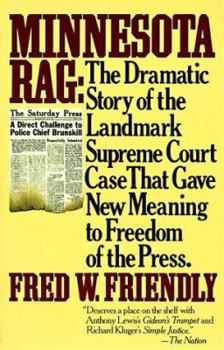Minnesota Rag
Select Format
Select Condition 
Book Overview
The fascinating behind-the-scenes story of this landmark First Amendment case Minnesota Rag takes the reader on an exhilarating tour of the seamy underside of a dark period in Minnesota's past, one... This description may be from another edition of this product.
Format:Paperback
Language:English
ISBN:0394712412
ISBN13:9780394712413
Release Date:August 1982
Publisher:Vintage Books USA
Length:243 Pages
Weight:0.60 lbs.
Dimensions:0.6" x 5.2" x 8.0"
Related Subjects
Biographical Biographies Biographies & History Biography & History Business & Investing Communication & Journalism Communication & Media Studies Constitutional Law History Journalism Journalism & Nonfiction Journalists Law Media Studies Midwest Politics & Government Politics & Social Sciences Professionals & Academics Regional U.S. Social Science Social Sciences State & Local Textbooks WritingCustomer Reviews
2 ratings
How a Scandal Sheet Made Legal History
Published by Thriftbooks.com User , 14 years ago
Minnesota Rag, by Fred W. Friendly Fred W. Friendly spent his life in journalism as a reporter, editor, teacher, and author. He worked with Edward R. Murrow on many distinguished news programs. This is the story about the Duluth `Rip-saw' and other muckraking journals that told about the connection of Duluth officials to the local underworld (p.4). Local newspapers were more interested with advertising than local corruption. Duluth was very important for its iron ore from the Mesabi Range (p.5). Chapter 1 describes the area and the times. Duluth was a company town owned by the steel and railroad companies. The wealthy lived in Victorian mansions. The articles in `Rip-saw' were popular (p.8). Prohibition meant liquor operators needed police protection and payoffs to politicians (p.9). Did `Rip-saw' sell advertising to eliminate unfavorable news items (p.12)? [Don't most newspapers today do this?] One of the important families, Pierce Butler, was appointed to the US Supreme Court (p.12). In October 1924 Morrison's paper claimed that a candidate for office suffered from a venereal disease, allowed "blind pigs" and slot machines (p.17). Publisher John L. Morrison admitted the information was "malicious and false" (p.20). Politicians and the major newspaper association cooperated to pass a "gag law" (p.21). [To prevent competition?] A single judge could stop publication forever (p.22)! Its passage was not mentioned in the newspapers. In April 1926 articles led to an injunction (p.24). Morrison left the state for health reasons, and died from a brain clot. The `Rip-saw' ceased publication (p.27). Chapter 3 tells about the hundreds of weekly scandal sheets published in the 1920s. Minneapolis was a crossroads for Canadian whiskey. Corruption provided stories omitted from respectable newspapers, such as the sexual adventures of the upper crust (p.32). When Guilford tried to expose the links between the police and gambling some gangsters tried to kill him. Chapter 4 starts by telling how an industry association used gangsters for price fixing. The police chief banned the `Saturday Press' in Minneapolis as obscene (p.44). County Attorney Floyd Olson asked for a permanent ban (p.51). Prominent attorney Thomas Latimer claimed the law was in violation of the state constitution. "There is no constitutional right to publish a fact merely because it is true" (p.62)! The ACLU defended Near over this "prior restraint" (p.63). Minnesota newspapers supported the Public Nuisance Law (p.64). `Chicago Tribune' publisher Robert McCormick supported the appeal to the US Supreme Court (p.90). Chapter 8 describes the politics and personalities of the US Supreme Court. Chapter 9 tells of the arguments in court. Chapter 10 discusses the vote to declare prior restraint unconstitutional and overturn the Minnesota law. A state legislature cannot alter a right in the US Constitution. Chief Justice Hughes read the decision (Chapter 11). Chapter 12 tells of the aftermath. Do peo
Historical Perspective
Published by Thriftbooks.com User , 21 years ago
Journalist, writer, producer, and professor Fred W. Friendly captures a slice of first amendment drama in his historic account of a landmark decision. His lack of objectivity shows, however, in such descriptions as "Morrison was a puritanical Christian of courtly dress and manners" (p. 8) and "Minnesota Rag" in the title. With that aside, Friendly goes on to provide the background of the individuals involved in this case. He tells readers of the prominent characters and their connection to the newspaper in question. Colonel McCormick, from Chicago, who had many more resources available than Jay Near in Minnesota, was drawn to the case due to press protection ramifications. Friendly goes on to describe how events unfolded.






